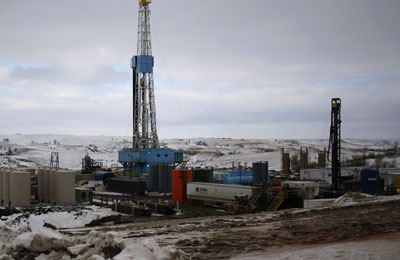
US propane, not crude, the real global disruptor
London, September 26, 2013
By Robert Campbell
The Bakken and Eagle Ford fields booms might get the most ink, but the biggest shakeup in global oil from the US shale revolution is likely to come from propane and other byproducts of shale gas production.
For the last few years soaring US natural gas liquids production, a category that encompasses ethane, propane, butane and other light liquids found in gas fields, has been the wallflower of the US energy industry.
Stuck in a constrained US market, these barrels did little more than fluff up grandiose editorial flights of fancy about production of US "liquids" surging past that of Russia and Saudi Arabia. Producers, meanwhile, fought tooth and nail to place their output in a saturated market.
Burgeoning American propane production isn't getting Vladimir Putin (Russian presdient) or Ali Al-Naimi (Saudi oil minister) worried yet. But quietly the US is emerging as a force in the global liquefied petroleum gas (LPG) market as new export facilities start up.
US LPG exports are poised to flood into global markets this year, catapulting the country to the top ranks of global exporters of the niche fuel and petrochemical feedstock.
Here a truism about commodity markets will be tested. Prices can fall hard or soar when a narrow equilibrium between supply and demand is upset. And that is precisely what is about to happen with LPG.
LPG is more than cooking fuel in poor countries and a source of heat in rural areas. It is also a petrochemical feedstock. When cheap and plentiful it can mount a stiff challenge to naphtha. Therein lies the root of the coming disruption to global oil trade.
Surging US LPG exports will likely help tip the supply and demand balance globally for the fuel and this will have a ripple effect through global oil markets.
Starting from essentially zero net exports as recently as 2012, the US will add a conservatively estimated 10 million tonnes a year to global LPG supplies by 2015. To put that in perspective, 10 million tonnes of LPG would equal 15 percent of the seaborne LPG traded worldwide, according to shipbrokers Joachim Grieg and Co.
SUPPLY EXPLOSION
Contrast that disruptive LPG supply increase with the US shale oil boom. Rising domestic oil output has backed out maybe 2.5 million barrels per day of foreign oil from the US market. But that is only a small fraction of the amount of crude traded worldwide.
Steady growth of demand for oil and lackluster increases in supply elsewhere have muted the impact of the shale crude boom. Resurgent US production has only helped cap oil price increases.
LPG will be a different story. Emerging as a major exporter almost overnight, the US may send world propane prices tumbling, especially since the expansion of the Panama Canal, when completed, will dramatically reduce transit times to Asia.
Indeed, the addition to global supplies could be far greater than 10 million tonnes per year if all the existing export plans on the drawing board are built.
The Houston facility of Enterprise Products Partners is already running at 8.2 million tonnes per year, more than its nameplate capacity, and the company said on Wednesday it would add a further 1.5 million tonnes per year of capacity by early 2015 due to strong demand from US producers.
Rival Targa Resources recently completed an expansion of its Houston-area terminal to allow it to export approximately 5 million tonnes a year of LPG, and the company plans to double the size of the plant by the third quarter of 2014.
Export facilities are also planned by Sunoco Logistics Partners as well as global commodities traders Vitol and Trafigura.
Cheaper US LPG will also force other producers, particularly those in the Middle East such as Saudi Arabia and Qatar that have long been able to act as price-setters, to compete more for market share.
Booming US LPG exports will "force (Middle Eastern) exports to re-examine their basic assumptions of pricing, domestic market controls and their future sales direction," according to Asia-Pacific Energy Consultants in a study released earlier this year on the impact of US shale LPG on global markets.
What then? If propane gets cheap enough, petrochemical plants in Asia that rely heavily on naphtha will have a strong incentive to increase their ability to process alternative feedstocks.
Processing propane in an ethylene cracker yields more ethylene but less of valuable co-products such as propylene than when naphtha is cracked. But producers will switch if the change in yields results in higher profits, especially if propane costs fall sharply relative to crude.
Here's where the LPG disruption cascades into the broader oil market. If naphtha loses competitiveness with petrochemical producers it will hit refinery profits hard, particularly in places like Europe that rely on exports of naphtha to stay in balance.
Intensified competition for the light end of the oil products barrel spells trouble, particularly as the shale boom in the US is threatening to send gasoline yields back up at US refineries.
The market will ultimately adjust. But it will take time. The slow nature of change in these markets means profit opportunities will abound for traders with the right equipment. But laggards will soon find themselves under pressure from an unforeseen place. - Reuters
The author is a Reuters columnist. The opinions expressed are his own







